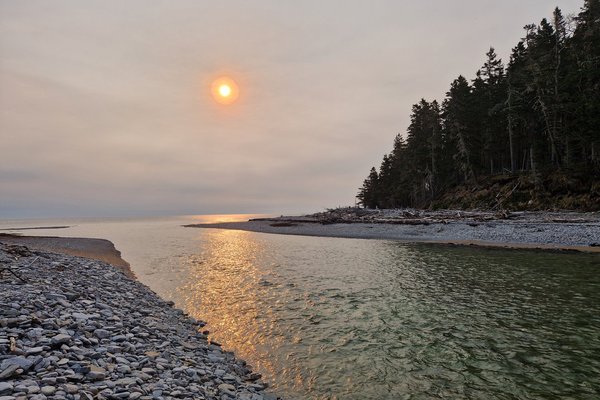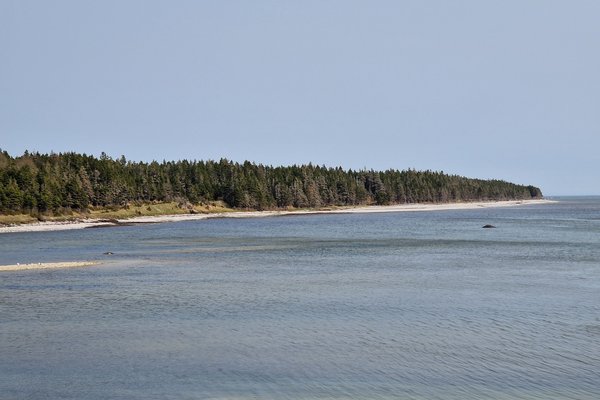Canada
Anticosti
Anticosti is an island where the virtual disappearance of life in the oceans 447-437 million years ago can be traced via fossils and layers of sediment.
The findings reflect the first recorded mass extinction event, which affected about 85% of marine organisms. The island's thick limestone layer holds the best-preserved fossil record of marine life at the end of the Ordovician and Silurian Periods. It especially allows for the study of shells and soft-bodied organisms that lived on the sea floor.
Community Perspective: although the site holds the same name as the island, included only are its coastline and the channels of its two principal rivers. Michael has described three ways to visit this remote island, while Wojciech found a reasonably priced flight from Labrador, which allows for a 24-hour stay.
Site Info
Official Information
- Full Name
- Anticosti (ID: 1686)
- Country
- Canada
- Status
-
Inscribed 2023
Site history
History of Anticosti
- 2023: Inscribed
- Inscribed
- Type
- Natural
- Criteria
- viii
Links
- UNESCO
- whc.unesco.org
- Related
-
- sepaq.com — Anticosti National Park
All Links
UNESCO.org
- whc.unesco.org — whc.unesco.org/
Related Resources
- sepaq.com — Anticosti National Park
Community Information
- Community Category
- Paleontology: Non-hominid fossils
Travel Information
Recent Connections
-
Perfect Inscriptions
2023 -
Otters
"la loutre (Lutra canadensis)" (Nomina… -
Natural sites filling gaps cited by IUCN
"The 2021 IUCN study "Geological World …
Connections of Anticosti
- Geography
-
-
Atlantic Ocean
Gulf of Saint Lawrence -
Linear inscriptions
The WHS follows nearly all the coastline of Anticosti island, and includes the Jupiter and Vaureal river valleys. "The roughly ring-shaped exposure around the coastal perimeter of the island features the entire Ordovician – Silurian interval for which the property is nominated." (IUCN Ev) – "(...) le bien proposé pour inscription s'étend sur près de 550 kilomètres de côte, soit la totalité de la rive de l'île, à l'exception du village de Port-Menier, et inclut le lit majeur des rivières Jupiter et Vauréal." (Nomination file, p. xxvi)
-
- Ecology
-
-
Otters
"la loutre (Lutra canadensis)" (Nomination file, p. 66) -
Fossils
"Anticosti is the best natural laboratory in the world for the study of fossils and sedimentary strata from the first mass extinction of life, at the end of the Ordovician period" (Crit viii) -
Lagerstätten
(Ordovician) Several references in the Nomination file "On a identifié les plus anciens vers rubanés, ronds et plats connus à ce jour grâce à une préservation exceptionnelle de ces petits animaux à corps mou (Konservat-Lagerstätte)".
-
- World Heritage Process
-
-
Perfect Inscriptions
2023 -
Inscribed on a single criterion only
Crit viii -
Natural sites filling gaps cited by IUCN
"The 2021 IUCN study "Geological World Heritage: a revised global framework for the application of criterion (viii) of the World Heritage Convention" highlighted as a significant gap on the World Heritage List "the interface between Palaeontology and global change over geological timescales, especially the mass extinction events", noting that (...) the equally profound Palaeozoic extinctions at the end of the Ordovician, Devonian and Permian are not yet represented on the World Heritage List. As a representative site of the O/S boundary interval, the nominated property would therefore fill an important identified gap on the World Heritage List." (Official description)
-
- Timeline
-
-
Paleozoic
"sediments of upper Silurian to lower Ordovician age that cover an interval from 447 to 437 million years" (AB ev)
-
- WHS Names
-
-
Misleading WHS Names
The included areas only cover 14% of the total area of Anticosti Island (its coastline and the channels of its two principal rivers).
-
News
No news.
Community Reviews
Show full reviews
During my visit to Newfoundland and Labrador, I really wanted to see Anticosti, and it turns out that the island can be perfectly incorporated into a trip to this province. WHS fans must take a ferry to Labrador to see Red Bay and they usually spend a night in Blanc Sablon or the surrounding area. From Blanc Sablon, a small Air Liaison plane flies to Sept-Iles and then to Port Menier, the only settlement on Anticosti. Next day is a flight back, so you basically have 24 hours on the island. A ticket purchased in advance is not very expensive (it cost me 400 CAD round trip), and the trip itself is an adventure. The plane from Blanc Sablon to Sept-Iles stops at four other airports along the way – St-Augustin, Chevery, La Romaine and Natashquan. These places on the southern coast of Labrador (though belonging to Quebec) have no road connection to the world (apart from the last one), and can only be reached by sea or air. I flew a small Beechcraft-19 plane with no boarding passes or airport security checks! I've flown many times in my life, but never like this. Unfortunately, the airline is not known for its punctuality - both flights were delayed by 7 hours! By the way - remember that flight times are in Quebec time zone, 1h 30 m difference with New Foundland time zone.
Anticosti is a large (from the eastern to the western tip it is about 300 kilometers) …
Keep reading 0 comments
Visit in May 2019
It is my understanding that the nomination of Île d'Anticosti, a large island in the Gulf of St Lawrence, is primarily supported by its being one of the premier locations for obtaining fossilized life from the Silurian epoch. If inscribed, the site will join several other Canadian fossil WHSs, and will share several features with those other sites. I was not able to determine exactly what the proposed boundaries of the site would be, or whether the site would include the entire island. From readings I did before arriving, it seems that fossils are often found wherever there is a rocky outcropping, especially at seaside cliffs and riverbanks. So it may be that most, or all, of the island is being nominated. The coordinates given on the UNESCO page for the site point to the western tip of the island, close to its one small village, which is where I made a brief visit. As of now, only a relatively small section at the center of the island is protected as a National Park.
Only an experienced paleontologist would be qualified to speak on the quality and number of the fossils present on the island, and whether they merit inscription on the list. However, there are two other situations that could affect this site’s chances of inscription. Over one hundred years ago, deer were introduced onto the island, which proliferated, and currently support the only significant tourism there. Specifically, hunters, who visit in relatively …
Keep reading 0 comments

